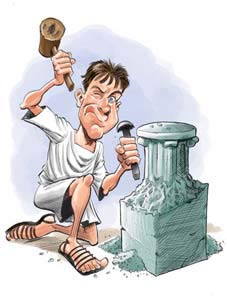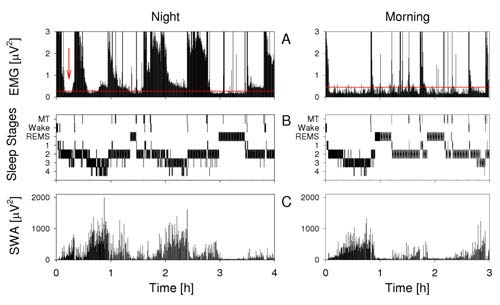- Like
- SHARE
- Digg
- Del
- Tumblr
- VKontakte
- Flattr
- Buffer
- Love This
- Save
- Odnoklassniki
- Meneame
- Blogger
- Amazon
- Yahoo Mail
- Gmail
- AOL
- Newsvine
- HackerNews
- Evernote
- MySpace
- Mail.ru
- Viadeo
- Line
- Comments
- Yummly
- SMS
- Viber
- Telegram
- JOIN
- Skype
- Facebook Messenger
- Kakao
- LiveJournal
- Yammer
- Edgar
- Fintel
- Mix
- Instapaper
- Copy Link
What is Muscle Tone?
An exercise scientist would define muscle tone as the minute muscular contraction which constantly exists in all skeletal muscles during relaxation.
Muscle tone is also known as residual muscle tension or tonus. Muscle tone is mentioned most often in sleep studies as muscle tone changes during different stages of sleep and has even been reported to cease during deep REM sleep.
You will often see muscle tone represented in charts and graphs (above) which chart the changes of muscle tone during different stages of sleep. Muscle tone increases with cardio and resistance training and can often decrease with flexibility training.
You Can have Too Much Muscle Tone!
When you asked “what is muscle tone?” you probably didn’t think you could actually have too much muscle tone but it is true.
Tight muscles exhibit hypertonicity which is a spastic state or condition with increased tendon reflexes. Muscles which have hypertonicity may create muscle imbalances and posture problems.
Very low muscle tone is called hypotonicity and is often exhibited in people with down syndrome and a host of other conditions.
If you asked “what is muscle tone” you probably weren’t looking for the scientific definition but it was worth a mention. The fitness industry has many terms which have conflicting scientific and popular beliefs which creates misinformation, confusion and even fitness myths.
What is Muscle Tone? (The Popular Definition!)

Muscle tone is the level of visibility of your muscles which is also commonly referred to as definition.
Having muscle tone means you can see the outlines of the muscles under your skin. Everyone has the muscles but not everyone is toned or defined which allows the muscles to be visible.
Muscle Tone Really Refers to Body Composition
Your body is covered with skin which has a layer of subcutaneous fat which covers.
If you have a high percentage of body fat which is covering your body you will not show muscle tone.
If you have a body fat percentage which is higher than average you have to lose some your body fat in order to improve your muscle tone.
If you have a body fat percentage which is lower than average or lean, you have to build muscle to increase your muscle tone.
There are no secrets about which exercises or diets improve muscle tone just the plain, simple science behind body composition. If you burn more calories than you consume you will gain body mass, if you burn fewer calories than you consume you will lose body mass.
Read about the proper way to gain muscle tone by losing body fat.
Muscle Tone: Frequently Asked Questions (FAQ)
Here are some of the most commonly asked questions about muscle tone.
Which exercises ‘Tone’ and which ‘Bulk’?
The correct answer is all exercises tone and bulk. Whether you gain weight or lose weight depends entirely on diet. You can perform any exercise if your are trying to tone provided you consume less calories than you burn.
How do you Improve Low Muscle Tone?
If your body fat percentage is high, you can improve your muscle tone by losing body fat which requires a sustained caloric deficit and usually occurs at 1-2 pounds per week.
If you currently have a low body fat percentage you may need to add some lean muscle to appear more toned. Perform resistance training 3-4 days per week and eat a few hundred calories extra every day to obtain more muscle definition.
What is the Difference between Toning and Sculpting?
 Toning is what you do to leather and sculpting is what you do to ice, stone or wood.
Toning is what you do to leather and sculpting is what you do to ice, stone or wood.
Both are made up words and have no significant scientific meaning. Toning and sculpting are the 2 most often used terms to sell gimmick fitness products because they are based on a popular fitness myth.
Spot reduction is a commonly believed myth in the fitness industry. The belief that an exercise aimed a body part’s fat can magically reduce the fat, or “melt fat” is completely false. Now you know you can’t tone or sculpt your fat away, the most important thing you can do during your exercise program is to measure your body fat.
About Michael Behnken
Mike Behnken is a personal trainer who holds multiple NASM certifications and a MS in Exercise Science. Mike loves fitness, travel, and photography among many other interests.

